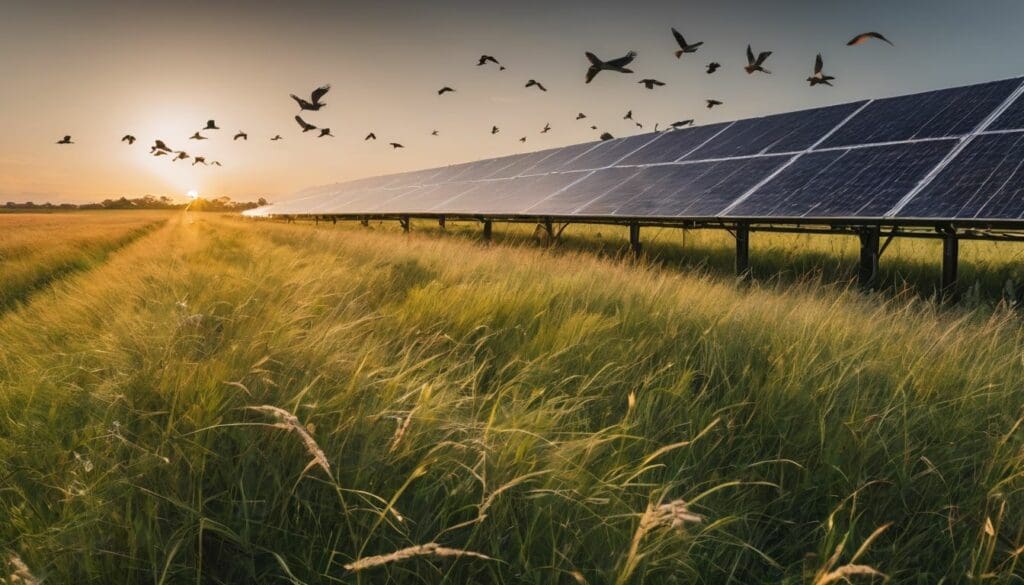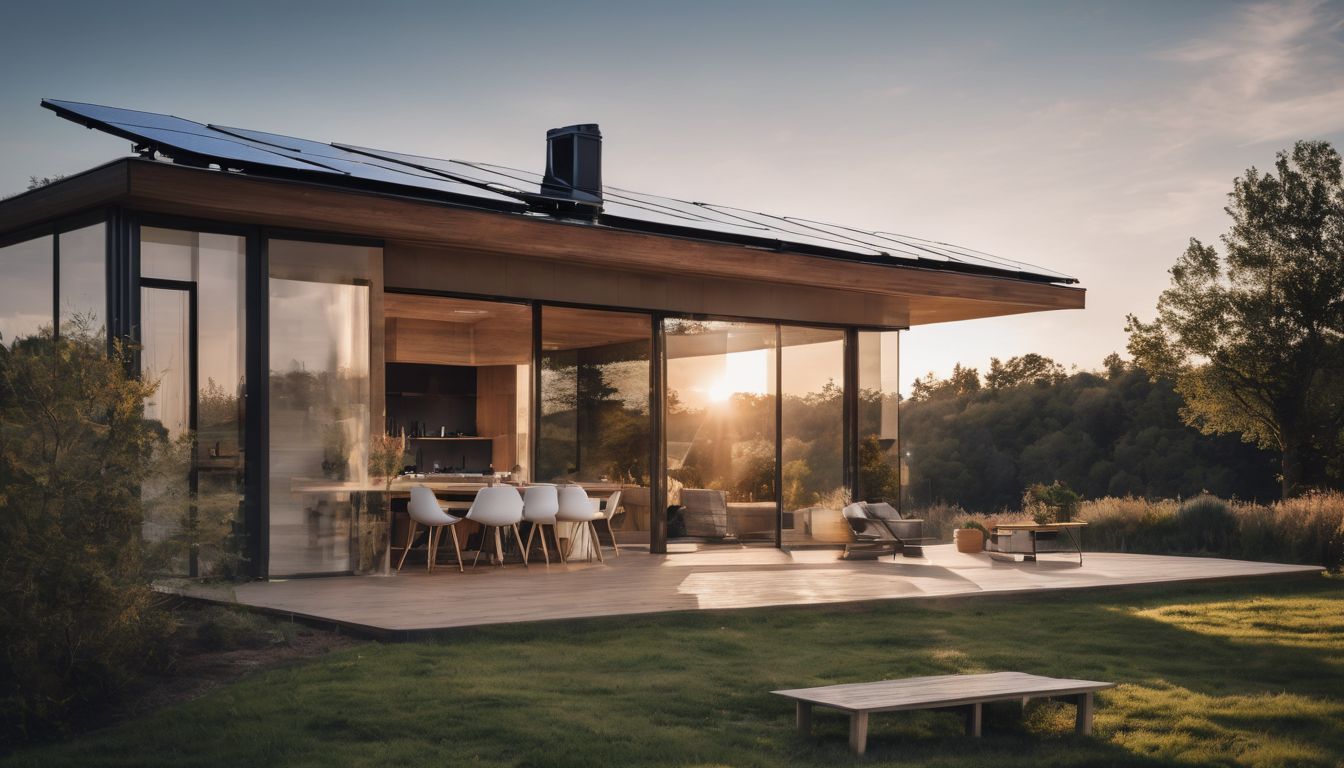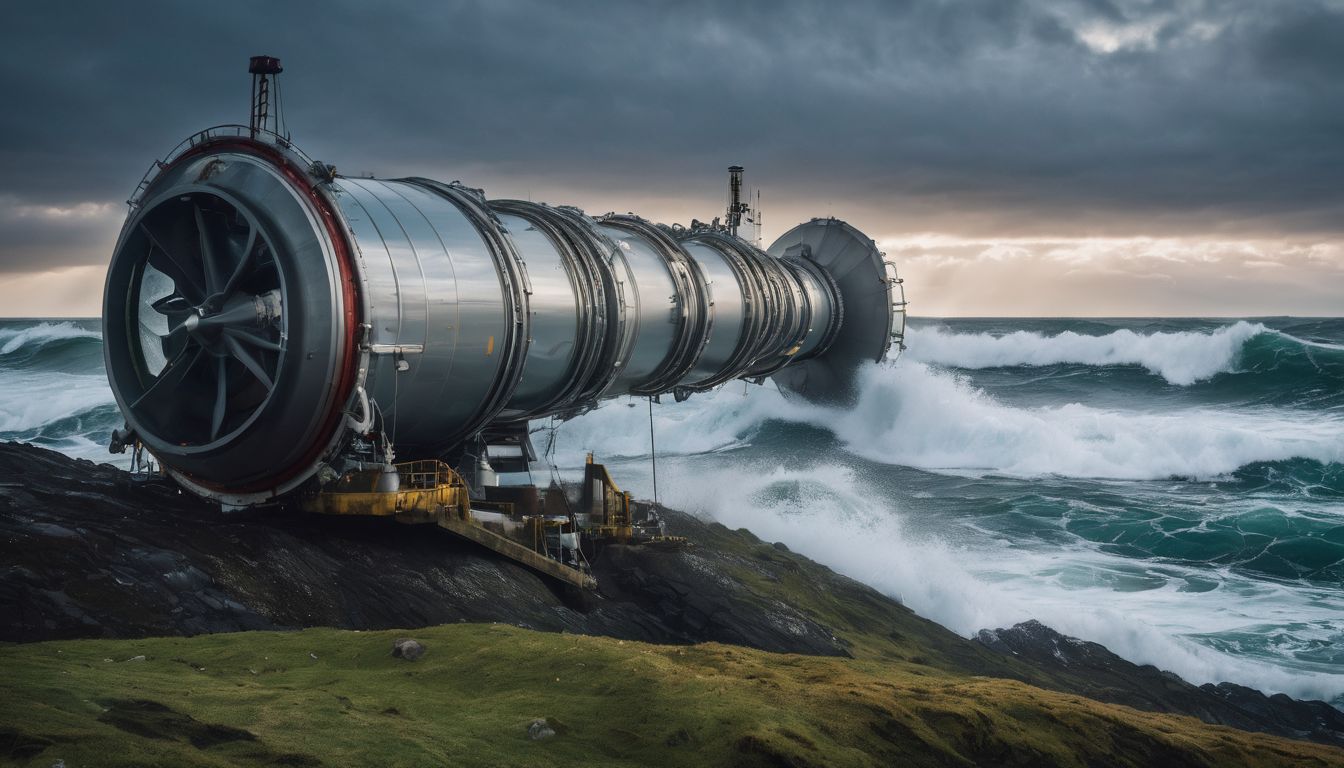As we harness the sun and wind to power our world, we must also remember the birds and beasts that share it with us. Renewable energy is crucial in combating climate change, yet its expansion can clash with wildlife interests.
Our article delves into this delicate balance, guiding you through thoughtful solutions to protect nature while embracing clean energy. Discover harmony between green power and wild spaces – keep reading!
Key Takeaways
- Renewable energy reduces reliance on fossil fuels, cutting down greenhouse gas emissions that contribute to climate change, which benefits the environment and wildlife.
- The development of renewable energy sources like wind turbines and solar farms can affect wildlife by disturbing habitats and causing harm through infrastructure, requiring mitigation efforts such as careful planning and wildlife-friendly designs.
- Protecting biodiversity is essential when expanding renewable energy; this includes habitat preservation techniques such as establishing protected areas and managing invasive species to support healthy ecosystems.
- Clean energy advancements not only decrease pollution but also encourage practices that safeguard natural habitats, aiding in the conservation of various species.
- Achieving a sustainable balance between renewable energy development and wildlife conservation demands collaborative efforts from all stakeholders, including governments, communities, and businesses.
The Need for Renewable Energy
Renewable energy is crucial for addressing climate change and meeting the increasing demand for energy. It offers a sustainable solution to reduce reliance on non-renewable resources.
Impact on climate change
Renewable energy sources play a crucial role in combating climate change. They replace fossil fuels, such as coal and oil, which produce large amounts of greenhouse gases when burned.
Greenhouse gases trap heat in the atmosphere, leading to global warming and severe weather changes.
Switching to renewable resources helps reduce these harmful emissions significantly. Solar panels and wind turbines generate electricity without releasing carbon dioxide or other pollutants into the air.
This shift towards sustainable energy not only protects our planet’s future but also promotes cleaner air and water for all forms of life. By investing in alternative energy sources, we take vital steps toward slowing down the rate of climate change, ensuring a healthier environment for generations to come.
Meeting energy demands
As energy demands grow, the need for sustainable solutions becomes increasingly urgent. Renewable energy sources offer a viable and environmentally friendly alternative to traditional fossil fuels.
These green energy sources such as solar, wind, and hydroelectric power are essential in meeting our current and future energy needs while reducing our impact on the environment.
Transitioning to renewable energy is crucial in addressing climate change and ensuring a cleaner, more sustainable future. By harnessing the power of natural resources like sunlight, wind, and water, we can meet rising energy demands without compromising the health of our planet or its wildlife habitats.
Balancing Renewable Energy and Wildlife
Preserving biodiversity is crucial when considering the impact of renewable energy on wildlife. Efforts to mitigate negative impacts and promote coexistence are essential in achieving a sustainable balance.
Importance of preserving biodiversity
Preserving biodiversity is crucial for maintaining a healthy and balanced ecosystem. Conserving diverse plant and animal species helps to sustain various habitats, contributing to the overall resilience of our environment.
Protecting biodiversity safeguards genetic diversity, ensuring that ecosystems can adapt to changing conditions over time.
Balancing renewable energy development with wildlife preservation requires thoughtful consideration and strategic planning. The coexistence of renewable energy initiatives and biodiversity conservation is key in achieving a sustainable future while responsibly meeting our energy needs.
Negative impacts on wildlife
Renewable energy development can negatively impact wildlife habitats. Construction of wind turbines, solar farms, and hydroelectric dams can disrupt ecosystems, leading to habitat loss for various species.
Similarly, increased noise levels from such installations can disturb the natural behavior of animals, affecting their breeding patterns and migration routes. Furthermore, the infrastructure associated with renewable energy projects has been linked to bird collisions and habitat fragmentation.
Moreover, the operation of renewable energy facilities poses risks to wildlife. For instance, birds and bats are at risk of colliding with wind turbine blades or being affected by pressure changes created by large-scale wind farms.
Efforts to mitigate negative impacts
- Implementing wildlife – friendly design principles in renewable energy projects to reduce harm to wildlife.
- Conducting thorough environmental assessments before development to identify potential risks and make informed decisions.
- Installing wildlife-friendly infrastructure, such as bird diverters on power lines and turtle exclusion devices in water-based renewables, to prevent harm.
- Collaborating with conservation organisations and researchers to develop and implement effective mitigation strategies.
Coexisting with Wildlife
Promoting habitat preservation and avian protection are crucial in balancing renewable energy development with wildlife conservation. Finding harmony in solar farm development is also essential for coexisting with wildlife.
Promoting habitat preservation
Habitat preservation is crucial for maintaining biodiversity and protecting wildlife. It involves creating and conserving natural spaces that provide food, water, shelter, and breeding grounds for a wide variety of species.
- Establishing protected areas: Designating specific regions as protected areas ensures that wildlife can thrive without human interference.
- Restoring degraded habitats: Rehabilitating degraded ecosystems helps to create healthier environments for wildlife to live in.
- Avoiding fragmentation: When developing land, it’s important to avoid breaking up habitats into isolated patches which can harm wildlife populations.
- Creating wildlife corridors: Conserving corridors between habitats allows animals to move freely and find resources more easily.
- Planting native vegetation: Reintroducing native plants supports the local ecosystem and provides essential resources for wildlife.
- Managing invasive species: Controlling invasive species helps maintain the balance of the ecosystem and supports native wildlife.
- Monitoring habitat health: Regular assessment and monitoring of habitats are necessary to understand how they change over time and take appropriate action when needed.
Avian protection
Protecting avian species is a crucial aspect of wildlife preservation in the face of renewable energy development. Implementing measures such as bird-friendly designs for wind turbines and solar farms can significantly reduce the risk to bird populations.
Engaging in thorough environmental assessments before construction and establishing protected areas around sensitive habitats are essential steps in ensuring the safety and conservation of avian species.
Moreover, ongoing research into avian behaviour around renewable energy infrastructure helps us better understand how these projects impact bird populations. By collaborating with experts and conservation organisations, we can develop innovative solutions that protect our feathered friends while advancing sustainable energy initiatives.
Finding harmony in solar farm development
To find harmony in solar farm development, it is crucial to implement measures that minimise the impact on wildlife. Planning and designing solar farms with regard to wildlife habitats can help mitigate negative effects.
By carefully selecting locations away from vital habitats and migration routes, solar energy expansion can coexist with wildlife.
Incorporating native vegetation around solar panels creates new habitats for local species while also reducing habitat fragmentation. Implementing avian protection measures such as bird-friendly designs and strategic placement of infrastructure minimises risks to birds.
Positive Impacts of Renewable Energy on Wildlife
Renewable energy development can lead to the safeguarding of wildlife habitats and contribute to the advancement of clean energy, promoting a sustainable future for both humans and wildlife.
To learn more about the benefits of renewable energy on wildlife, keep reading!
Clean energy advancement
Renewable energy advancement positively impacts wildlife by reducing reliance on fossil fuels and actively safeguarding their habitats. Solar, wind, and hydroelectric power contribute to cleaner air and water, promoting healthier ecosystems for diverse wildlife.
Embracing clean energy technologies plays a crucial role in protecting endangered species and preserving biodiversity. By prioritising sustainability over traditional energy sources, we secure a better future for both the environment and its inhabitants.
As we transition towards renewable energy, advancements in technology enable us to minimise the impact on wildlife habitats. The development of innovative solutions such as avian protection measures ensures harmonious coexistence between renewable energy infrastructure and local fauna.
Safeguarding wildlife habitats
Preserving wildlife habitats is crucial for maintaining biodiversity. Conserving natural spaces ensures that various species have suitable environments to thrive in. Protecting these habitats involves implementing sustainable practices and creating protected areas to safeguard the homes of diverse wildlife.
Efforts must be made to maintain and restore critical habitats, such as wetlands, forests, and grasslands. By doing so, we can help ensure the long-term survival of many species. Mitigating human impacts on these ecosystems is essential for promoting healthy wildlife populations and preserving the delicate balance of our planet’s biodiversity.
Conclusion: Achieving a Sustainable Balance
Renewable energy development must prioritise preserving biodiversity and minimising negative impacts on wildlife, requiring responsible and collaborative efforts for a sustainable future.
Read more to discover how renewable energy can coexist with wildlife for the benefit of our environment and ecosystems.
The role of renewable energy in preserving biodiversity
Renewable energy plays a vital role in preserving biodiversity by reducing the environmental impact of traditional energy sources. By transitioning to clean, sustainable energy solutions, we can safeguard wildlife habitats and protect endangered species.
Solar and wind farms offer opportunities for responsible development that minimises disruption to natural habitats, promoting coexistence with wildlife.
Efforts towards achieving a sustainable balance involve the responsible development of renewable energy projects that prioritise wildlife protection. This includes avian protection measures and advocating for habitat preservation alongside clean energy advancement.
Collaborative efforts are essential to ensure the successful integration of renewable energy while safeguarding our precious ecosystems for future generations.
The importance of responsible development
Responsible development of renewable energy is crucial for ensuring the preservation of wildlife habitats and the promotion of biodiversity. By incorporating sustainable practices into the planning and implementation of renewable energy projects, we can minimise negative impacts on wildlife while advancing clean energy initiatives.
It is imperative to consider the long-term effects on ecosystems and species when developing renewable energy infrastructure, as this approach fosters a harmonious coexistence between human progress and natural environments.
Collaborative efforts from all stakeholders are essential in achieving responsible development that safeguards both our planet’s precious wildlife and its transition towards cleaner energy sources.
Collaborative efforts for a sustainable future
The importance of responsible development paves the way for collaborative efforts towards a sustainable future. Active participation from various stakeholders, including governments, conservation organisations, and renewable energy developers, is crucial in ensuring a harmonious coexistence between renewable energy projects and wildlife habitats.
Collaboration involves shared goals and responsibilities in safeguarding biodiversity while advancing clean energy technologies. Through ongoing dialogue and joint initiatives, these collaborations can yield innovative solutions for minimising the impact on wildlife and promoting a sustainable future.
Efforts to achieve a sustainable future also require community involvement and public education on the importance of balancing renewable energy needs with wildlife preservation. By fostering collective understanding and engagement, we can create an environment where responsible development principles guide decision-making for a sustainable future that benefits both humanity and wildlife.
FAQs
1. What does “Renewable Energy and Wildlife: A Balancing Act” mean?
It means finding a way to switch to renewable energy while also taking care of wildlife and their homes.
2. Why is it important to think about wildlife during the energy transition?
We must protect animals and nature as we start using more wind, solar, and other renewable power sources.
3. Can renewable energy projects harm wildlife?
Yes, if not planned carefully, things like wind turbines or solar farms can affect where animals live and how they behave.
4. How can we make sure renewable energy doesn’t hurt wildlife?
By studying how animals live and planning our green energy projects wisely, we can keep them safe while making clean power.





